Hands-On Danger Education
Experiencing latent dangers in the field
Fuji Electric's unique Hands-On Danger Education program
Safety must be given the highest priority on all sites. Companies provide safety education in the aim of achieving a zero-accident rate. In addition to conventional safety education, Fuji Electric provides Hands-On Danger Education, where engineers are encouraged to improve their ability to foresee and predict industrial accidents by noticing the presence of latent dangers in the field to raise safety awareness, in the aim of achieving a zero-accident rate.
The importance of training field service engineers
The Field Technology Training Center is located in the Fuji Electric Tokyo Factory in Hino City, Tokyo. At Fuji Electric, engineers with specialized skills in installation and maintenance at customer and other sites, or in the field, are called “field service engineers.” The training of field service engineers is an important issue that can be considered the company’s lifeline.
On-the-job training (OJT), in which employees learn the importance of workplace safety and work quality through working on site, is a common type of employee education. Fuji Electric has also adopted this method, but there were some problems with it.
Isao Kida, General Manager of the Field Technology Training Center, says:
“Field service engineers were often trained by dispatching inexperienced engineers to the field together with senior engineers. However, in order to further raise customers’ trust in terms of facilities and safety measures, we needed to develop an educational environment that would allow us to maintain and improve basic technical skills for equipment and systems in-house.”
For that reason, in 2012, we established a training center equipped with various types of electrical equipment to reproduce an environment similar to a customer site.。
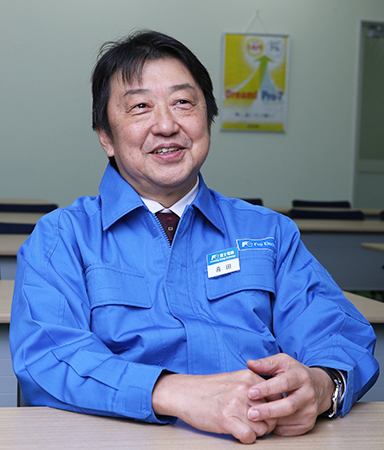
Isao Kida,
General Manager, Fuji Electric Field Technology Training Center
Original Hands-On Danger Education
Since it was first established, the Field Technology Training Center has provided safety education as well as technical education. Specifically, we felt the need to provide a more effective program in the form of Hands-On Danger Education, which would help prevent accidents by enabling employees to experience and learn where in their work risks are hidden. At first, we used external training.
Kida explains the situation at that time:
“About 20 years ago, a steel company independently developed Safety Experience Education, a form of safety education provided to new employees at manufacturing sites. It became more and more popular and widespread among field sales services. The training involved visiting customers in a trailer loaded with equipment for the hands-on program, which was installed to provide experience for the trainees. We also considered raising our employees’ safety awareness through this danger experience.”
While it did have an effect, as time went by, new problems began to emerge. First, employees could only participate in the program if they were available in a certain place at a certain time on a certain day. With 1400 Fuji Electric field service engineers across Japan (including partner companies), it was difficult to have them all take the course.
Preparing necessary items in-house
We needed to build a permanent facility in the company so that employees could take the course at any time. When we were building the system, we added an original program, specifically, one that assumes electrical accidents.
“We spent a year seeking out and purchasing the necessary educational equipment, piece by piece.
But many of the things we needed were not commercially available, such as items related to electrical short circuits. We created those in-house,”
says Katsuyuki Takahashi, a lecturer in Hands-On Danger Education.
Currently, most of the lecturers are seasoned employees with experience in quality assurance, electrical machinery plants commissioning, and many other fields, so they have thorough knowledge of the possible dangers on site and of the details of past accidents.
Their experience is reflected in the educational programs.
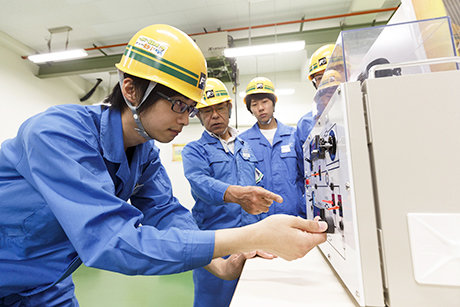
Employee experiencing ground fault interruption
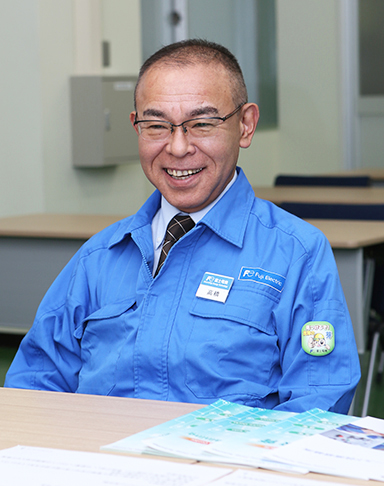
Katsuyuki Takahashi,
Manager in charge, Fuji Electric Field Technology Training Center
If you’ve experienced something for yourself, it’s hard to forget and it leads to action
As a result, Hands-On Danger Education began in April 2018 as a regular course intended for employees.
Conventional safety education consists mainly of classroom lectures. By combining this with practical training on what not to do or what can invite danger, participants can consciously develop the ability to avoid danger.
“What you learn in a classroom is important, but tends to be forgotten over time. But if you’ve experienced something for yourself, it’s hard to forget. In particular, the younger generation is living in an environment where all dangers have been eliminated. I find it increasingly important to give them a simulated experience like this,”
says Masatoshi Nose, Manager of the Field Technology Training Center.
“Compared with the past, the products and environments around us (such as cars and playground equipment) are safer. The sources of danger in our daily lives have been gradually eliminated. This makes it all the more necessary to develop a sensitivity to danger by using and sharpening our five senses so that we can feel danger. We hope to improve employees’ ability to predict danger by continuing to provide this danger experience regularly and by repeating the experience so as to instill a sense for danger in their consciousness. This will make it possible to naturally take actions on site to avoid danger. Our goal is to prevent accidents and achieve a zero-accident rate by making engineers aware of danger so they can foresee and predict accidents in order to taken action.”
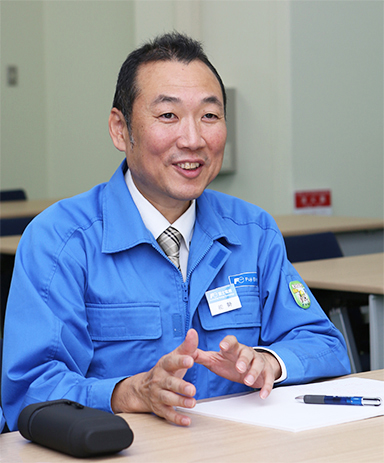
Masatoshi Nose, Manager,
Fuji Electric Field Technology Training Center
More people should think about safety
Through trial and error, we have improved our educational programs for hands-on danger education. Talking about the future of hands-on danger education, Aya Yanagi of the Training Center says:
“We will strive to improve our danger experience education to achieve even higher safety quality on site, and not only dispatch engineers to sites but also have all employees experience danger education. This will make it known internally and externally that Fuji Electric is thoroughly ensuring safety on site. While safety standards and approaches differ from country to country, I would like to invite people from overseas sites to participate in the training so that they can learn about Fuji Electric's safety quality.”
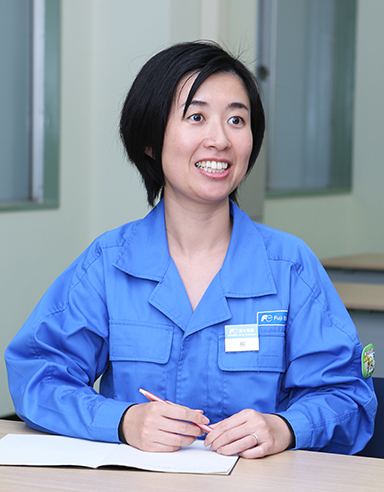
Aya Yanagi, Fuji Electric Field Technology Training Center
Simulated experiences using virtual reality (VR)
This educational program uses facilities with virtual reality (VR) to provide experiences that cannot otherwise be simulated, such as power supply short circuit and electric wire overheating, ground fault interruption, electric shock, the importance of helmets, drop impact, safety belt hanging, getting caught and pinched, and moving up and down ladders and stepladders.
Three pieces of VR content are currently prepared: falling from heights, falling from an opening, and electric shock from a power distribution board modification.
“While VR may sound like a game, it uses a site that is faithfully reproduced, so when you wear the headset, it really feels like you’re there. Participants should be more aware of safety behavior on site after the experience.”
From now on, we will aim to achieve a zero-accident rate in the field while further improving hands-on danger education for better safety education.
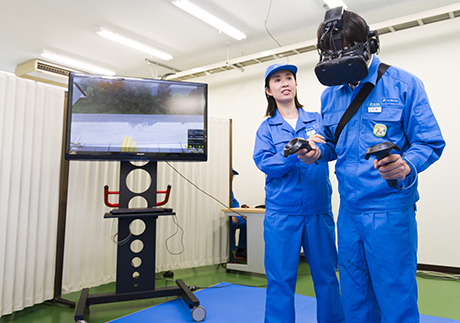
Similar experience by using VR


